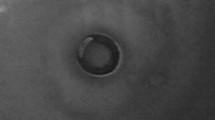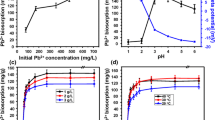Abstract
The study of metal-tolerant bacteria is important for bioremediation of contaminated environments and development of green technologies for material synthesis due to their potential to transform toxic metal ions into less toxic compounds by mechanisms such as reduction, oxidation and/or sequestration. In this study, we report the isolation of seven lead-tolerant bacteria from a metal-contaminated site at Zacatecas, México. The bacteria were identified as members of the Staphylococcus and Bacillus genera by microscopic, biochemical and 16S rDNA analyses. Minimal inhibitory concentration of these isolates was established between 4.5 and 7.0 mM of Pb(NO3)2 in solid and 1.0–4.0 mM of Pb(NO3)2 in liquid media. A quantitative analysis of the lead associated to bacterial biomass in growing cultures, revealed that the percentage of lead associated to biomass was between 1 and 37% in the PbT isolates. A mechanism of complexation/biosorption of lead ions as inorganic phosphates (lead hydroxyapatite and pyromorphite) in bacterial biomass, was determined by Fourier transform infrared spectroscopy and X-ray diffraction analyses. Thus, the ability of the lead-tolerant isolates to transform lead ions into stable and highly insoluble lead minerals make them potentially useful for immobilization of lead in mining waste.




Similar content being viewed by others
References
Akpor OB, Muchie M (2010) Remediation of heavy metals in drinking water and wastewater treatment systems: processes and applications. Int J Phys Sci 5(12):1807–1817
Bai J, Yang X, Du R, Chen Y, Wang S, Qiu R (2014) Biosorption mechanisms involved in immobilization of soil Pb by Bacillus subtilis DBM in a multi-metal-contaminated soil. J Environ Sci 26(10):2056–2064
Batta N, Subudhi S, Lal B, Devi A (2013) Isolation of a lead tolerant novel bacterial species, Achromobacter sp. TL-3: assessment of bioflocculant activity. Indian J Exp Biol 51:1004–1011
Borremans B, Hobman JL, Provoost A, Brown NL, van Der Lelie D (2001) Cloning and functional analysis of the pbr lead resistance determinant of Ralstonia metallidurans CH34. J Bacteriol 183(19):5651–5658
Chen B, Liu JN, Wang Z, Dong L, Fan JH, Qu JJ (2011) Remediation of Pb-resistant bacteria to Pb polluted soil. J Environ Prot 2(2):130–141
Cutting SM, Vander Horn PB (1990) Genetic analysis. In: Harwood CR, Cutting SM (eds) Molecular biological methods for Bacillus. Wiley, Sussex, pp 27–74
Das SK, Guha AK (2007) Biosorption of chromium by Termitomyces clypeatus. Colloids Surf B 60(1):46–54
Doshi H, Ray A, Kothari IL (2007) Biosorption of cadmium by live and dead Spirulina: IR spectroscopic, kinetics, and SEM studies. Curr Microbiol 54(3):213–218
Drancourt M, Bollet C, Carlioz A, Martelin R, Gayral JP, Raoult D (2000) 16S ribosomal DNA sequence analysis of a large collection of environmental and clinical unidentifiable bacterial isolates. J Clin Microbiol 38(10):3623–3630
El-Shanshoury AERR, Elsilk SE, Ateya PS (2013) Uptake of some heavy metals by metal resistant Enterobacter sp. isolate from Egypt. Afr J Microbiol Res 7(23):2875–2884
Elsilk SE, El-Shanshoury AERR, Ateya PS (2014) Accumulation of some heavy metals by metal resistant avirulent Bacillus anthracis PS2010 isolated from Egypt. Afr J Microbiol Res 8(12):1266–1276
Gong J, Zhang Z, Bai H, Yang G (2007) Microbiological synthesis of nanophase PbS by Desulfotomaculum sp. Sci China Ser E 50(3):302–307
Govarthanan M, Lee KJ, Kim JS, Kamala-Kannnan S, Oh BT (2013) Significance of autochthonous Bacillus sp. KK1 on biomineralization of lead in mine tailings. Chemosphere 90(8):2267–2272
Holt JG, Rieg NR, Sneath PHA, Staley JT, Williams ST (1994) Bergey’s manual of determinative bacteriology, 9th edn. Williams and Wilkins, Maryland
Hookoom M, Puchooa D (2013) Isolation and identification of heavy metals tolerant bacteria from industrial and agricultural areas in Mauritius. Curr Res Microbiol Biotechnol 1(3):119–123
Jarosławiecka A, Piotrowska-Seget Z (2014) Lead resistance in microorganisms. Microbiology 160(1):12–25
Kamika I, Momba MNB (2013) Assesing the resistance and bioremediation ability of selected bacterial and protozoan species of heavy metals in metal-rich industrial wastewater. BMC Microbiol 13:28
Kandeler E (2007) Physiological and biochemical methods for studying soil biota and their function. In: Paul EA (ed) Soil microbiology, ecology, and biochemistry, 3rd edn. Elsevier, Burlington, pp 53–83
Kim SU, Cheong YH, Seo DC, Hur JS, Heo JS, Cho JS (2007) Characterisation of heavy metal tolerance and biosorption capacity of bacterium strain CPB4 (Bacillus spp.). Water Sci Technol 55(1–2):105–111
Kneipp J, Lasch P, Baldauf E, Beekes M, Naumann D (2000) Detection of pathological molecular alterations in scrapie-infected hamster brain by Fourier transform infrared (FT-IR) spectroscopy. Biochim Biophys Acta 1501(2):189–199
Leedjärv A, Ivask A, Virta M (2008) Interplay of different transporters in the mediation of divalent heavy metal resistance in Pseudomonas putida KT2440. J Bacteriol 190(8):2680–2689
Levinson HS, Mahler I (1998) Phosphatase activity and lead resistance in Citrobacter freundii and Staphylococcus aureus. FEMS Microbiol Lett 161(1):135–138
Levinson HS, Mahler I, Blackwelder P, Hood T (1996) Lead resistance and sensitivity in Staphylococcus aureus. FEMS Microbiol Lett 145(3):421–425
Loukidou MX, Zouboulis AI, Karapantsios TD, Matis KA (2004) Equilibrium and kinetic modeling of chromium (VI) biosorption by Aeromonas caviae. Colloid Surf A 242(1):93–104
Mac Faddin JF (1984) Pruebas bioquímicas para la identificación de bacterias de importancia clínica, 2nd edn. Médica Panamericana SA (ed) Williams and Wilkins, Baltimore
Mire CE, Tourjee JA, O’Brien WF, Ramanujachary KV, Hecht GB (2004) Lead precipitation by Vibrio harveyi: evidence for novel quorum-sensing interactions. Appl Environ Microbiol 70(2):855–864
Mohseni M (2014) Bioremediation activity of Pb(II) resistance Citrobacter sp. MKH2 isolated from heavy metal contaminated sites in Iran. J Sci I R Iran 25(2):105–111
Murthy S, Bali G, Sarangi SK (2014) Effect of lead on growth, protein and biosorption capacity of Bacillus cereus isolated from industrial effluent. J Environ Biol 35(2):407–411
Nichols PD, Henson JM, Guckert JB, Nivens DE, White DC (1985) Fourier transform-infrared spectroscopic methods for microbial ecology: analysis of bacteria, bacteri-polymer mixtures and biofilms. J Microbiol Methods 4(2):79–94
Pandey S, Saha P, Biswas S, Maiti TK (2011) Characterization of two metal resistant Bacillus strains isolated from slag disposal site at Burnpur, India. J Environ Biol 32:773–779
Pérez MPJA, García-Ribera R, Quesada T, Aguilera M, Ramos-Cormenzana A, Monteoliva-Sánchez M (2008) Biosorption of heavy metals by the exopolysaccharide produced by Paenibacillus jamilae. World J Microbiol Biotechnol 24:2699–2704
Rensing C, Sun Y, Mitra B, Rosen BP (1998) Pb(II)-translocating P-type ATPases. J Biol Chem 273(49):32614–32617
Richards JW, Krumholz GD, Chval MS, Tisa LS (2002) Heavy metal resistance patterns of Frankia strains. Appl Environ Microbiol 68(2):923–927
Roane TM (1999) Lead resistance in two bacterial isolates from heavy metal-contaminated soils. Microbial Ecol 37(3):218–224
Santos-Santos E, Yarto-Ramírez M, Gavilán-García I, Castro-Díaz J, Gavilán-García A, Rosiles R, Suárez S, López-Villegas T (2006) Analysis of arsenic, lead and mercury in farming areas with mining contaminated soils at Zacatecas, Mexico. J Mex Chem Soc 50(2):57–63
Singh SK, Tripathi VR, Jain RK, Vikram S, Garg SK (2010) An antibiotic, heavy metal resistant and halotolerant Bacillus cereus SIU1 and its thermoalkaline protease. Microbial Cell Fact 9:59
Socrates G (2004) Infrared and Raman characteristic group frequencies: tables and charts, 3rd edn. Wiley, Chichester
Sparks DL (2005) Toxic metals in the environment: the role of surfaces. Elements 1(4):193–197
Tchounwou PB, Yedjou CG, Patlolla AK, Sutton DJ (2012) Heavy metals toxicity and the environment. Mol Clin Environ Toxicol 101:133–164
Varghese R, Krishna MP, Babu VA, Hatha AM (2012) Biological removal of lead by Bacillus sp. obtained from metal contaminated industrial area. J Microbiol Biotech Food Sci 2(2):756–770
Weisburg WG, Barns SM, Pelletier DA, Lane DJ (1991) 16S Ribosomal DNA amplification for phylogenetic study. J Bacteriol 173(2):697–703
Yilmaz EI (2003) Metal tolerance and biosorption capacity of Bacillus circulans strain EB1. Res Microbiol 154(6):409–415
Zanardini E, Andreoni V, Borin S, Cappitelli F, Daffonchio D, Talotta P, Cariati F (1997) Lead-resistant microorganisms from red stains of marble of the Certosa of Pavia, Italy and use of nucleic acid-based techniques for their detection. Int Biodeterior Biodegrad 40(2):171–182
Acknowledgements
We thanks and appreciate the technical support of the M.D. Beatriz A. Rivera Escoto from Laboratorio Nacional de Investigaciones en Nanociencias y Nanotecnología (LINAN-IPICYT). The authors would like to express their gratitude to Consejo Nacional de Ciencia y Tecnología (CONACyT) for the financial support and scholarship for V.R.S. (Grants LINAN-0271911 and FOMIX-ZAC-2013-C01-202597).
Author information
Authors and Affiliations
Corresponding author
Ethics declarations
Conflict of interest
All authors declare that they have no conflict of interests
Rights and permissions
About this article
Cite this article
Rodríguez-Sánchez, V., Guzmán-Moreno, J., Rodríguez-González, V. et al. Biosorption of lead phosphates by lead-tolerant bacteria as a mechanism for lead immobilization. World J Microbiol Biotechnol 33, 150 (2017). https://doi.org/10.1007/s11274-017-2314-6
Received:
Accepted:
Published:
DOI: https://doi.org/10.1007/s11274-017-2314-6




